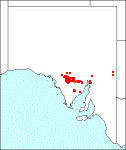Family: Asteraceae
Senecio gawlerensis
Citation:
M. Lawr., J. Adelaide Bot. Gard. 7:292 (1985).
Synonymy: S. georgianus DC. var. latifolius J. Black, Fl. S. Aust. 613 (1929).
Common name: (Grey) groundsel.
Description:
Erect glabrescent perennial shrub, 80-120 cm tall, slender at first, becoming stout and woody with age, new growth mainly from woody upper branches, sometimes from a subterranean caudex; stems cylindrical, striate; leaves coriaceous, broad-lanceolate to widely ovate in outline, 4-8 x 1.5-4 cm, rarely to 12 x 9 cm, deeply toothed or pinnatifid with 4 or 5 lobes on each side, lobes obtuse, entire or irregularly toothed, or lanceolate and acute, sinuses rounded, subpetiolate, glabrous at maturity, often densely cobwebby when young.
Inflorescence a very dense terminal spherical or corymbose panicle of 30-80 capitula; peduncles 4-9 mm long; involucre 6-8 x 3-4 mm; bracts 11-14 rarely 16, cobwebby toward the base; calyculus of 2-4 linear bracteoles; florets 15-25, exserted 1-2 rarely 3 mm beyond the involucre at anthesis.
Achenes usually straw-coloured, sometimes dark-brown, subcylindrical, 2-3 x 0.5-0.8 mm, with short hairs, appressed in broad rows in and around the narrow grooves.
|
|
Distribution:
|
Among rocky outcrops, usually toward the summit of hills, occasional on the lower slopes among rocks or near watercourses.
S.Aust.: GT, FR, EP.
|
Conservation status:
native
Flowering time: Aug. — Nov.
|

SA Distribution Map based
on current data relating to
specimens held in the
State Herbarium of South Australia
|
Biology:
No text
Taxonomic notes:
S. gawlerensis was treated as var. latifolius of S. georgianus DC. by Black (1929) Fl. S. Aust. 613 but the two species are quite distinct in capitulum and leaf morphology.
S. georgianus DC. is a poorly understood discoid species now thought to be extinct. It is known only from a few scattered early collections from temperate Australia (Tas. to south-western W.Aust.), including three from the northern Lofty Ranges. It was collected in 1844-5 by Behr from Bethany (specimens presumably at Halle) and from "Salt Gulley" in March, 1849 (two sheets in the National Herbarium, Melbourne). Mueller collected it from "low hills around the Wheal Barton mines" in January, 1851. His specimen at Melbourne is the type of Senecio helichrysoides F. Muell., Trans. & Proc. Vict. Inst. (1855) 1:39. This was reduced to S. georgianus by Benth., Fl. Aust. (1867) 3:670, although the type is much more densely tomentose than any of the other collections of Candolle's species which we have seen.
Material identified as S. georgianus resembles S. cunninghamii DC. in general aspect, rather than S. quadridentatus Labill. as stated by Black (1928) Fl. S. Aust. 613. It is distinguished by leaves narrowly lanceolate (rather than linear-lanceolate), by more numerous florets (up to 40), and usually by tomentose pubescence.
Author:
Not yet available
|

